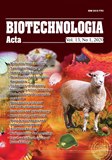ISSN 2410-7751 (Print)
ISSN 2410-776X (Online)

Biotechnologia Acta V. 13, No 1, 2020
Р. 30-37, Bibliography 18, English
Universal Decimal Classification: 615.322:616.37
https://doi.org/10.15407/biotech13.01.030
1 Uzhhorod National University, Ukraine
2 University of Veterinary Medicine and Pharmacy in Ko?ice, Slovakia
The purpose of this work was to study the antimicrobial, antibiofilm-forming and antioxidant properties of alcohol extracts of Arnica montana L. and Achillea millefolium L. The plants for the analysis were gathered in the territory of Velyky Berezny region, Transcarpathia. Ethyl and methyl extracts were produced from inflorescences of Arnica montana L. and Achillea millefolium L. For the purpose of analysis, we used Staphylococcus genus bacteria that had been isolated from the mouth cavities and pharynx of human patients suffering from inflammatory diseases, by plating into differentially diagnostic nutrient media with subsequent identification. All isolates were characterized to be biofilm-forming.
The subject of the study was extract’s antimicrobial activity evaluated by the diffusion-into-agar method in standard 96-well plates using the spectrophotometric method and by measuring of antioxidant activity (DPPH test).
t was established that Arnica montana L. extracts exerted a more pronounced antimicrobial activity upon the analysed isolates of Staphylococcus genus bacteria. It was furthermore shown that Arnica montana L. extracts displayed an antimicrobial effect even upon MRSA of S. aureus. Extracts of Arnica montana L. and Achillea millefolium L. were shown to possess anti-biofilm forming properties.
Ethyl and methyl extracts of Arnica montana L.and Achillea millefolium L. were shown to reveal significant antioxidant activity.
Thus, our results indicated a need in further research of possible application of Arnica montana L. and Achillea millefolium L. extracts as anti-staphylococcal agents, which could be employed for the treatment of inflammatory processes in mouth cavity and oropharynx.
Key words: antimicrobial effect, antibiofilm formation, plant extracts.
© Palladin Institute of Biochemistry of National Academy of Sciences of Ukraine, 2020
References
1. Kryvtsova M. V. Microscopic Candida genus fungi in the structure of microbial associations in the condition of generalized periodontitis and their sensitivity to antibiotics and essential oils. Bulletin of Problems Biology and Medicine. 2019, 1 (2), 263?266. https://doi.org/10.29254/2077-4214-2019-1-2-149-263-266
2. Piegerov? A., Ko??ov? J., Schusterov? P., Nemcov? R., Kryvtsova M. In vitro inhibition of biofilm formation by Staphylococcus aureus under the action of selected plant extracts. Folia Veterinaria. 2019, 63 (1), 48–53. https://doi.org/10.2478/fv-2019-0007
3. Kriplani P., Guarve K., Baghael U. S. Arnica montana L. ? a plant of healing: review. J. Pharm. Pharmacol. 2017, 69 (8), 925–945. https://doi.org/10.1111/jphp.12724
4. Mazova I. S., Apykhtin N. N., Plemenkov V. V. Chemotaxonomy of common yarrow Achillea millefolium L. Khimiya rastitelnogo syria. N 3, P. 85–88.
5. Safonov N. N. A complete atlas of medicinal plants. Moskva: EKSMO. 2009.
6. O'Toole G., Kaplan H. B., Kolter R. Biofilm formation as microbial development. Annu Rev Microbiol. 2000, V. 54, P. 49?79. https://doi.org/10.1146/annurev.micro.54.1.49
7. Medini F., Fellah H., Ksouri R., Abdelly C. Total phenolic, flavonoid and tannin contents and antioxidant and antimicrobial activities of organic extracts of shoots of the plant Limonium delicatulum. J. Taibah University for Science. 2014, 8 (3), 216?224.https://doi.org/10.1016/j.jtusci.2014.01.003
8. Koo H., Gomes B. P. F. A., Rosalen P. L., Ambrosano G. M. B., Park Y. K., Cury J. A. In vitro antimicrobial activity of propolis and Arnica montana against oral pathogens. Archives of Oral Biology. Elsevier. 2000, 45 (2), 141–148. https://doi.org/10.1016/S0003-9969(99)00117-X
9. Vorobets N. M., Bilynska I. S., Piniazhko O. B. Protymikrobni vlastyvosti arniky hirskoyi (Antimictobial properties of mountain arnica). Botanichni systemy. 2011, 3 (3), 222–224.
10. El-Kalamouni C., Venskutonis, P., Zebib B., Merah O., Raynaud C., Talou T. Antioxidant and Antimicrobial Activities of the Essential Oil of Achillea millefolium L. Grown in France. Medicines. 2017, 4 (2), 30. https://doi.org/10.3390/medicines4020030
11. Rasha N. Hasson. Antibacterial Activity of Water and Alcoholic Crude Extract of Flower Achillea millefolium. Rafidain J. Sci. 2011, 22 (5), 11?20. https://doi.org/10.33899/rjs.2011.6518
12. Stojanovi? G., Radulovi? N., Hashimoto T., Pali? R. In vitro antimicrobial activity of extracts of four Achillea species: The composition of Achillea clavennae L. (Asteraceae) extract. J. Ethnopharmacol. 2005, 101 (1?3), 185–190. https://doi.org/10.1016/j.jep.2005.04.026
13. Iauk L., Lo Bue A. M., Milazzo I., Rapisarda A., Blandino G. Antibacterial activity of medicinal plant extracts against periodontopathic bacteria. Phytotherapy Res. 2003, 17 (6), 599–604. https://doi.org/10.1002/ptr.1188
14. Kryvtsova M. V., Trush K., Eftimova J., Ko??ov?, J., Spivak M. J. Antimicrobial, antioxidant and some biochemical properties of Vaccinium vitis-idea L. Mikrobiol. Zh. 2019, N 3, P. 40?52. https://doi.org/10.1002/ptr.1188
15. Kryvtsova M. V., Ko??ov? J., Eftimova J., Spivak M. J. Antimicrobial, antibiofilm-forming and some biochemical properties of Potentilla erecta rhizome extract. Biotechnol. acta. 2019, 5 (12), С. 82?88. https://doi.org/10.15407/biotech
16. Yang J., Paulino R., Janke-Stedronsky S., Abawi F. Free-radical-scavenging activity and total phenols of noni (Morinda citrifolia L.) juice and powder in processing and storage. Food Chem. 2007, V. 102, P. 302–308. https://doi.org/10.1016/j.foodchem.2006.05.020
17. Scalbert A. Antimicrobial properties of tannins. Phytochemistry. Elsevier. 1991, 30 (12), 3875–3883. https://doi.org/10.1016/0031-9422(91)83426-L
18. Shukla V., Bhathena Z. Broad spectrum anti-quorum sensing activity of tannin-rich crude extracts of indian medicinal plants. ScientificaCairo. 2016, P. 1?8. https://doi.org/10.1155/2016/5823013

